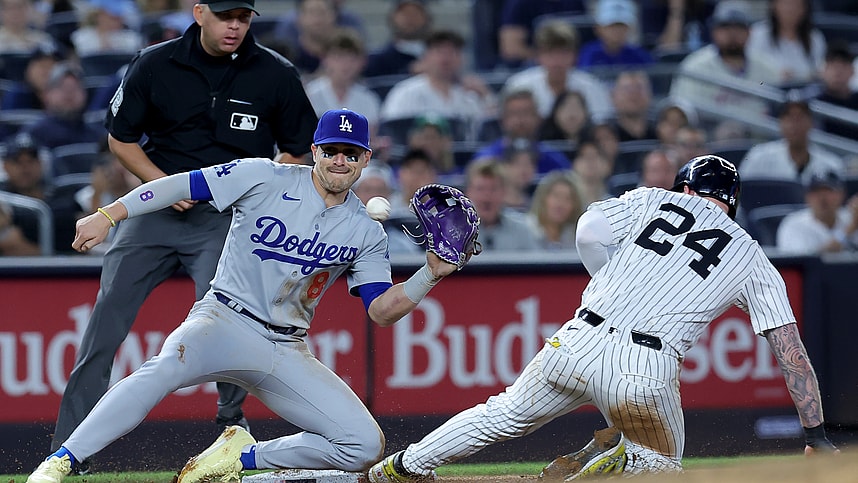
For the first time since 2009, the New York Yankees will play in the World Series, and opposing them is a familiar opponent at this stage of the season. The star-studded Los Angeles Dodgers, headlined by living legends and All-Stars, are looking to get some revenge for the beatdowns the Yankees have handed them in the Fall Classic dating back to their Brooklyn days.
Before we even discuss matchups; there’s a level of allure and star power in this series that we may never see play against each other again. Multiple former MVPs, Cy Young Award winners, and rising young stars will grace the diamond on both rosters, making for a true clash of titans. The Yankees open as the slight underdogs in this best-of-seven series, as they look to finally win a series they weren’t favored in for the first time since they made a 2-0 comeback to beat Cleveland in 2017.
It’s MVP versus MVP, juggernaut versus juggernaut, and two franchises yearning to re-create the magic of their glory days.
Can the Yankees Hold Down the Dodgers’ Insane Lineup?
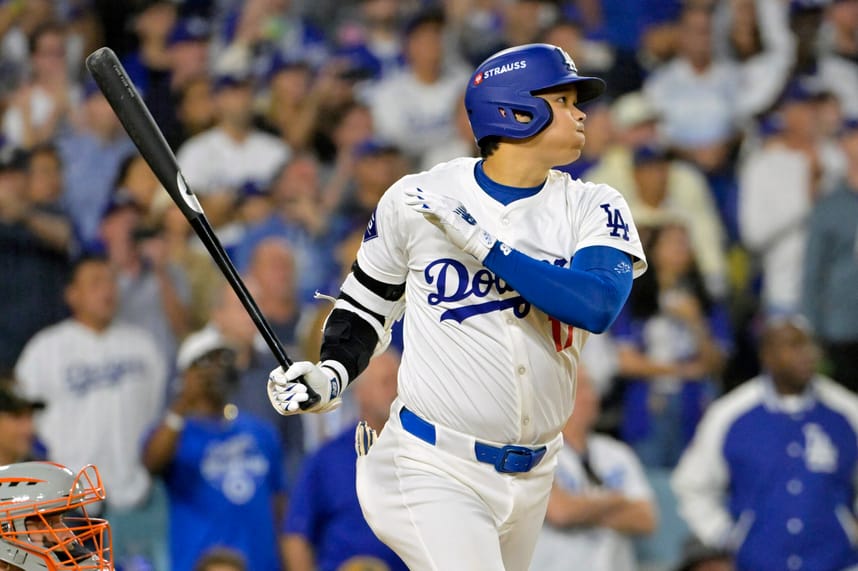
The Los Angeles Dodgers have an exhausting lineup that can wear down even the best of pitchers, as they have a fearsome trio backed by some strong supplemental bats. Shohei Ohtani, Mookie Betts, and Freddie Freeman are all locks to make the Hall of Fame and are all in their prime, but is there anything we can learn from how teams have pitched to them to try and limit them?
Shohei Ohtani: .310/.390/.646 | 181 wRC+ | 54 HR | 9.1 fWAR
There’s no denying who the best player in the National League was this season, as Shohei Ohtani provided power and speed at levels we have quite literally never seen before. A once-in-a-lifetime talent, the Yankees have to fear Los Angeles’ new leadoff hitter in a way they haven’t feared a hitter before. He has an xwOBA of at least .400 against every single pitch except the sweeper, having the ability to crush any pitch someone decides to throw at him. Ohtani chases less than the average hitter but will also jump over anything he can do damage with, making him nearly unstoppable.
Nearly is the operative word here; Shohei Ohtani is still human (somehow) and that makes him inherently flawed. Cutters from righties up and in to can give him fits, and it can set up the slider down and in for a chase and strikeout.
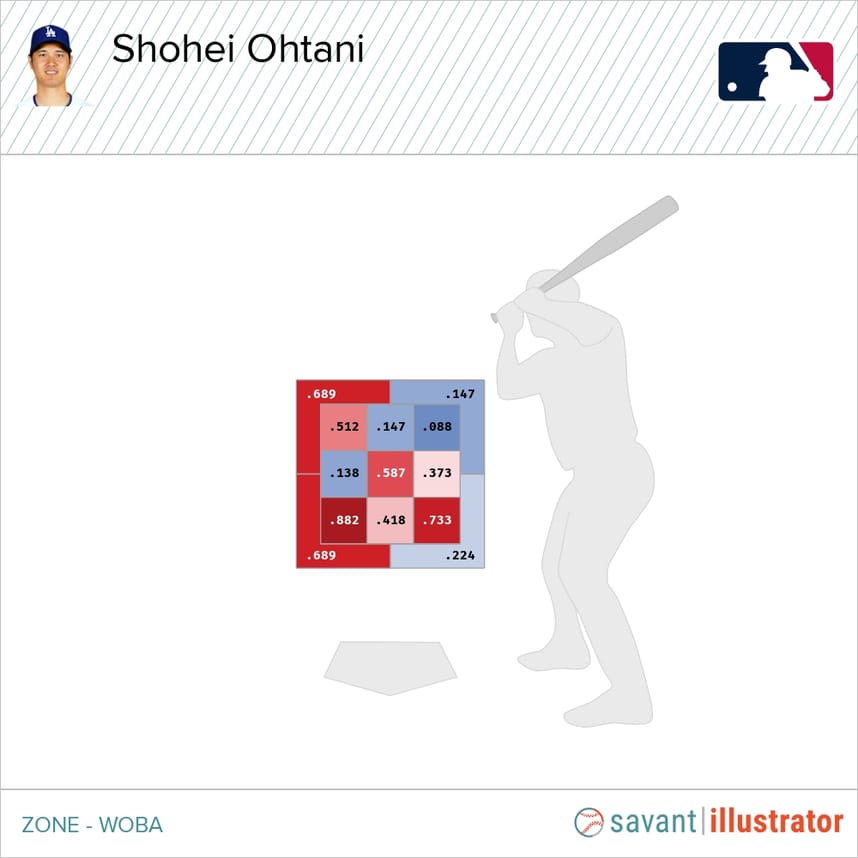
Most of Shohei Ohtani’s strikeouts come against pitches down and in, which are usually breaking balls, and the Yankees are well-equipped to execute cutters and sliders specifically. Their active roster slider Stuff+ (131) is by far the best in baseball and they’re also sixth in cutter Stuff+ (104), so that should help them hold a chance against one of the biggest threats in the sport.
In terms of specific pitchers who the Yankees should try and get on the mound against Shohei Ohtani, Nestor Cortes stands out as a strong option. He struggles against left-handed four-seamers up in the zone and is outright abysmal against sweepers from southpaws as well. In 12 matchups against Cortes, Ohtani has just two hits with zero extra-base hits, and with the Yankees likely using him out of the bullpen, he can serve as a nice counterpunch to the likely NL MVP.
There is no way to truly “stop” Shohei Ohtani, but you can try and give yourself the best chance of limiting his damage output. Don’t walk the batters ahead of him, don’t be afraid to walk him if you’re behind in the count, and don’t forget that he can swipe second base in a flash.
Mookie Betts: .289/.372/.491 | 141 wRC+ | 19 HR | 4.4 fWAR
Another former MVP who bedeviled the New York Yankees when he was with the Boston Red Sox, Mookie Betts is having by far his best postseason with four home runs and a 184 wRC+. The pitch that Betts has had the hardest time handling is the sweeper, as he has a .267 wOBA against that pitch this season and some well-detailed struggles against pitches with good sweep moving away from Betts. Right-handed changeups also seem to give him fits, and that fits well into the Yankees’ pitching staff.
Jake Cousins immediately stands out as the kind of reliever who could give Mookie Betts some issues, having the kind of slider with tons of horizontal movement from a wide release point. Clarke Schmidt could also be a great matchup for Betts as he has two different breaking balls that can cause Betts to whiff and chase out of zone, but ultimately the same logic for Ohtani applies here.
You aren’t going to silence Mookie Betts completely, but breaking balls away gives you the best shot of getting him out right now. The Yankees have an incredible group of arms that can throw all different kinds of sliders from different angles and multiple movement profiles. Even someone like Mark Leiter Jr. would have some utility here since he doesn’t throw many fastballs (mostly because they aren’t good).
Freddie Freeman: .282/.378/.476 | 137 wRC+ | 22 HR | 4.0 fWAR
Trying to heal from an injury that has rendered him effectively useless in the postseason, Freddie Freeman is usually one of the best players on the planet. His 137 wRC+ this season is his lowest mark with the Dodgers thus far, but he’s still an excellent bat-to-ball hitter with above-average power. He doesn’t burn you with the long ball as often as most first basemen, instead racking up doubles and giving pitchers literal nightmares since he rarely chases or whiffs.
Full-stop; this is the lane for Tim Hill to come into a game to try and limit the future Hall of Fame first baseman as he has a -4 Run Value against sinkers with a mere .305 wOBA against left-handed sinkers in the regular and postseason combined. Given his lack of speed, the Yankees could walk Mookie Betts and try to get Freeman to roll over into a double play if you’re in a late-game situation.
READ MORE: Yankees give $162 million the Game 2 start for the World Series
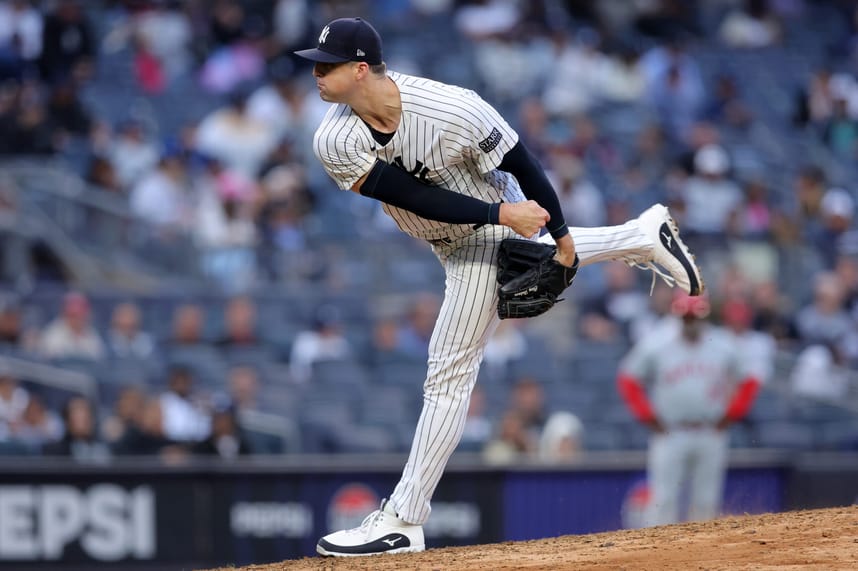
Clay Holmes could also be an excellent option against Freddie Freeman, who has a .274 wOBA against sinkers at or above 95 MPH. The Yankees should still fear Freeman, but he has to prove that his ankle injury won’t continue to limit him any more than it has thus far in October. He has a 31 wRC+ and .219 SLG% through the first two rounds of the postseason, will the layoff between the NLCS and World Series get him back to his Hall of Fame form?
Attacking the Rest of LAD’s Lineup
Teoscar Hernandez: Few hitters have as much raw power as the 32-year-old slugger, who launched a career-best 33 home runs with a .840 OPS in his first season with the Dodgers. Sliders and sweepers away and four-seamers up are the best ways to get him out, but the New York Mets tried some interesting tactics that I would like to see the Yankees deploy as well. Hernandez saw a lot of sinkers up and inside during the NLCS, a pitch that the Mets utilized to jam him inside by getting him to chase out of zone and generate soft contact. I wonder if the sinker-heavy Yankees do the same.
Max Muncy: I love how Max Muncy swings and he has a ton of pop in his bat, the kind of hitter who will feast on the short porch in the Bronx. Lefties can strike him out and limit some of his power, but righties have their work cut out for them when he’s at the plate. With a 145 wRC+ in those matchups, there isn’t much they can do outside of trying to attack down-and-in or up-and-away. Just because he isn’t one of their three best hitters doesn’t mean you can throw whatever to him.
Will Smith: The hard-hitting catcher has struggled against changeups from left-handed and right-handed pitchers, and righties have been able to neutralize him by attacking the outer half of the plate consistently. He has a 134 wRC+ against left-handed pitching and a 102 wRC+ against right-handed pitching, the Yankees should make sure that Smith can’t get the platoon advantage that he was able to get against the left-handed heavy Mets.
Gavin Lux: A strong second half hasn’t carried into October, but Lux is still a threat thanks to his solid contact rates and patient approach at the plate. He has a 17 wRC+ against left-handed pitching so I expect the Dodgers to use Chris Taylor over him when Carlos Rodon starts. Firm gyro sliders are a great way for righties to handle Lux, but he also has a.299 wOBA against four-seamers at or above 95 MPH. Attack the top of the zone with heat and sit him down with sliders.
Tommy Edman: Make him swing from his left-handed side, where he has a .227 wOBA hitting from in both the regular and postseason combined. Dating back to last season, velocity has given Tommy Edman trouble at times, especially when it’s a four-seamer. This is important for someone like Carlos Rodon, who will 100% face Edman in Game 2, as he can try to get the free-swinging utilityman to put a ball in play early in a count and get a quick out against one of the best lineups in the sport.
Enrique Hernandez: One of the biggest playoff risers in the sport, he has two homers and a 145 wRC+ in the postseason thus far. He has not hit a single home run on a pitch at or above 95 MPH this season and posted a -13 Run Value against four-seamers; attack him with firm velocity upstairs until he proves he can handle it.
Chris Taylor: At this point, Taylor is more of a defense-first player, but the Yankees could still see him at the plate during the series. His hands aren’t as quick as they used to be, just attack him with velocity upstairs and firm sliders away. Sweepers have become a pitch he can handle well and he doesn’t chase much, so throwing a big looping breaking ball would only serve to benefit an aging bat with regressing power tools
Andy Pages: The rookie outfielder has a ton of power and plays a strong outfield, but he has the typical rookie issues of poor chase rates and strikeout numbers. Righties have a lot of success attacking the outside part of the plate against him since that’s where most of his whiffs and soft contact come from, but lefties have their work cut out for them. Pages only strikes out 21.7% of the time against southpaws with a .398 wOBA, but he does have some issues with four-seamers upstairs, so there could be a weakness there for NYY to exploit.
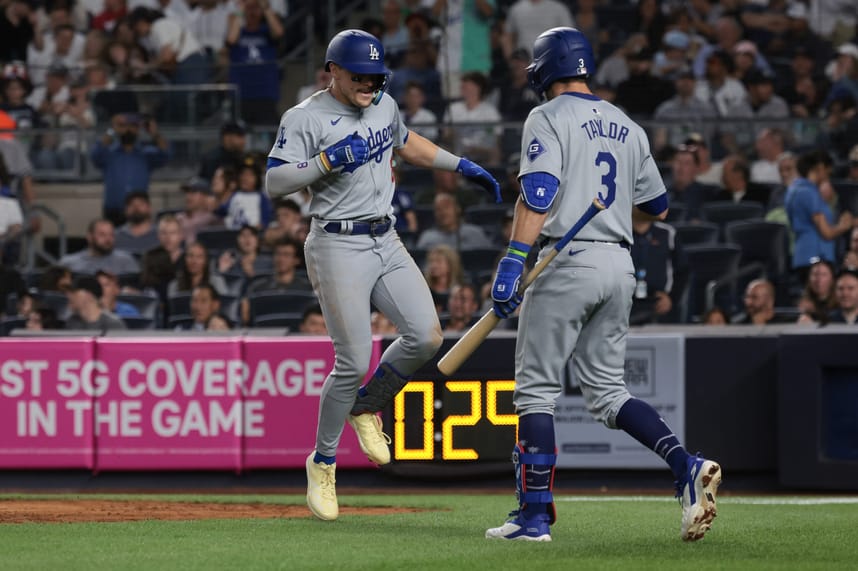
The Dodgers won’t chase at junk, are all over anything in-zone, and have enough depth to wear a pitcher down by the third inning. It’s an offense that mirrors the Houston Astros, who throttled the Yankees four times in the last decade, but the Yankees have some tools to have success. A lot of their pitchers have excellent sliders they can use to handle some of LA’s top hitters while also having some good velocity up and down the roster.
Now that we know the Los Angeles Dodgers can mash, how does their pitching staff shape up and can the Yankees take them down?
The Dodgers’ Bullpen-Oriented Pitching Plan
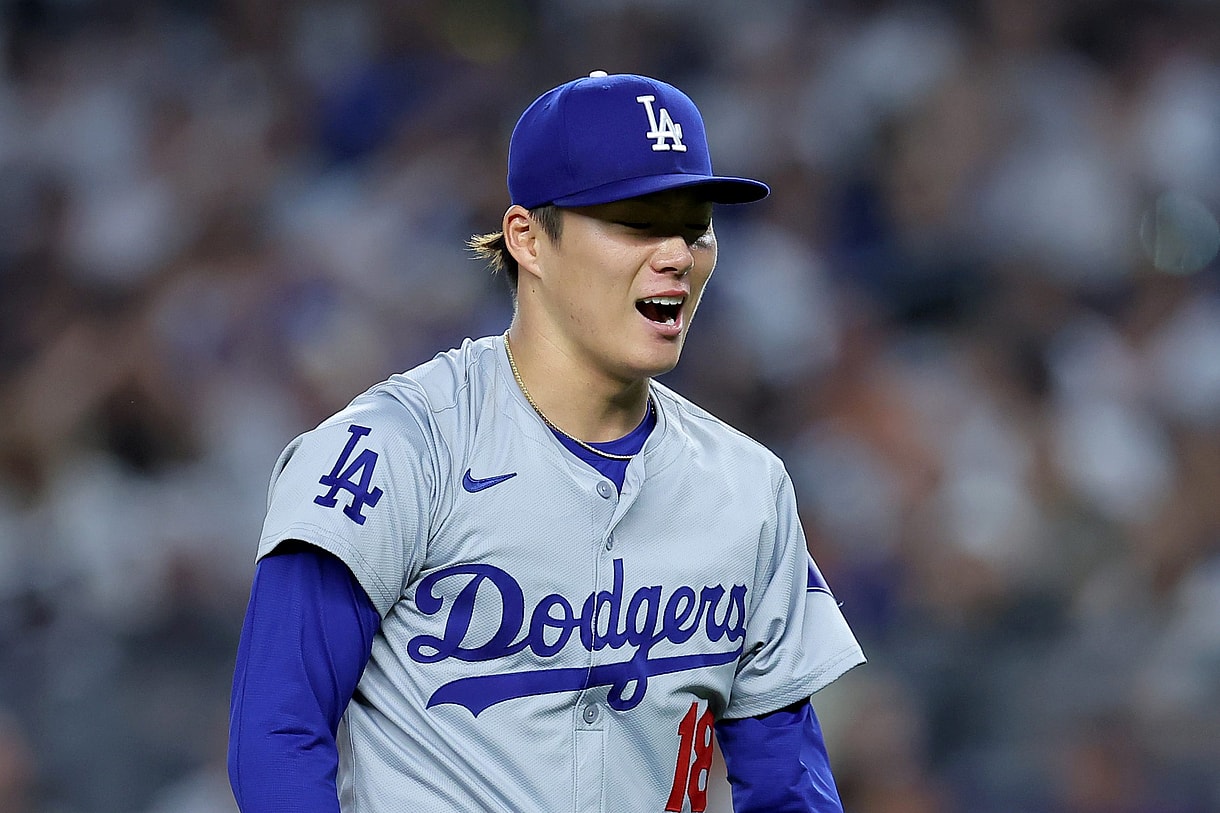
The Los Angeles Dodgers will sport a three-man rotation with a bullpen game being their fourth “starter” in the series, but it remains to be seen how many of their arms will be available in relief. Alex Vesia and Brudsar Graterol could both make their returns after dealing with injuries, but the starting three remains intact with Jack Flaherty, Yoshinobu Yamamoto, and Walker Buehler getting the starts.
Jack Flaherty (Game 1): 162.0 IP | 3.17 ERA | 3.48 FIP | 29.9% K% | 5.9% BB% | 1.33 HR/9
On paper, the Los Angeles Dodgers have an ace-caliber pitcher going in Game 1 of the World Series, but recent trends would raise some concern about Jack Flaherty. His fastball velocity is down a full MPH over his last six starts, with a massive drop-off in whiffs and an increase in damage contact allowed. Through three postseason starts, Flaherty has a 7.04 ERA and 11.9% K%, and while he dominated in Game 2 of the NLCS against the Mets, he got absolutely smoked in Game 5 when he allowed eight runs and didn’t strike out a single batter.
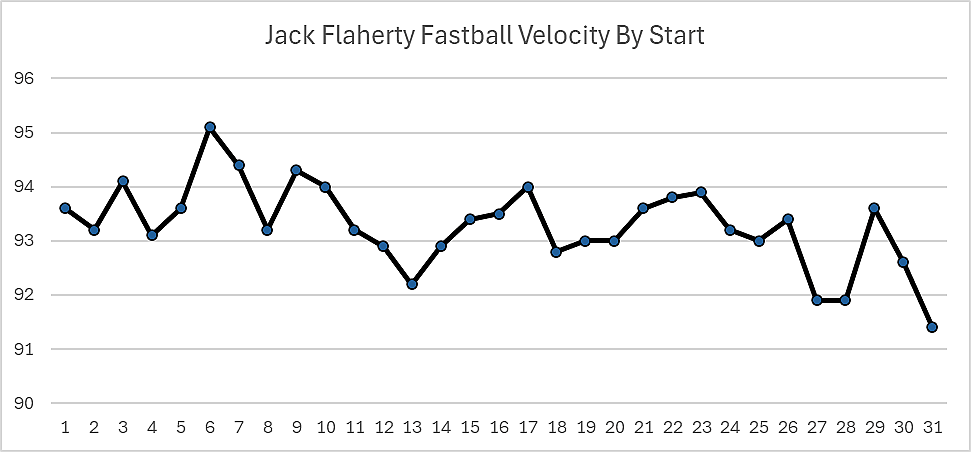
His fastball velocity is trending in the right direction, and President of Baseball Operations Andrew Friedman mentioned that Flaherty had been working through mechanical issues to end the season. If his stuff doesn’t return to normal when he goes on the mound in Game 1, the Yankees need to shell the fastball and force him out of the game early. The Dodgers are using a bullpen game in one of these first four games, they need to work those relievers early and often.
Right-handed batters have a .445 SLG% and 1.77 HR/9 against him, and while the Yankees are more left-handed than they’ve been in recent years, I think this bodes well for the top of the lineup. Gleyber Torres, Aaron Judge, and Giancarlo Stanton immediately greet Flaherty out of the jump, and if the Yankees want to force Dave Roberts to make an uncomfortable decision, they could deliver a crushing blow in the first three innings.
Jack Flaherty is still firing great breaking balls, so if he’s able to mask his fastball somehow, the Yankees will have a long day at the plate.
Yoshinobu Yamamoto (Game 2): 90.0 IP | 3.00 ERA | 2.61 FIP | 28.5% K% | 6.0% BB% | 0.70 HR/9
This postseason hasn’t treated Yoshinobu Yamamoto perfectly well, as he’s posted a 5.11 ERA with just a 21.2% K%, but I’m not remotely concerned about his ability to perform in the World Series if I’m a Dodgers fan. The right-hander has A-grade stuff, and over his last two starts he’s been able to limit the run scoring and struck out eight batters against the Mets in Citi Field as well. With the Dodgers going to the Japanese-born ace in Game 2, he’ll get an extra day of rest when he goes again in Game 6, keeping him sharp for both World Series starts he would have in a seven-game set.
He has a similar issue against right-handed batters as Flaherty does, allowing a .453 SLG% and .317 wOBA against them on the season. The development of a sharp slider with some good two-plane movement has made his arsenal even better, and the Yankees will have their work cut out for them. What the Dodgers do well is get ahead early with fastballs, and Yoshinobu Yamamoto is no different. He uses his fastball 40.4% of the time normally, but 53.8% of the time as the first pitch in the count.
Whether it’s a lefty or righty, Yamamoto will attack the outside part of the plate to ensure that he can steal a strike and get ahead in the count, so if the Yankees can sit on the fastball and see if a pitch leaks over the middle of the plate, they could get a very hittable pitch to take out of the yard. His fastball hasn’t been a high-whiff offering for him this season, nor was it when he pitched in Japan, and the Yankees were second in wOBA (.363) against right-handed four-seamers in the regular season and playoffs combined.
Walker Buehler (Game 3): 75.1 IP | 5.38 ERA | 5.54 FIP | 18.6% K% | 8.1% BB% | 1.91 HR/9
While I had a lot of good to say about Yoshinobu Yamamoto and believe the rest between the NLCS and World Series could do Jack Flaherty well, Walker Buehler is the kind of pitcher the Yankees need to demolish. He does have a good cutter that he should utilize more than his four-seamer alongside his sweeper, but the inability to pitch deep into games coupled with a lack of overpowering stuff should allow New York to do a ton of damage and force the Dodgers to use their bullpen early.
He’s pitched just nine innings in his two starts with a 6.00 ERA, and while he held his own against the New York Mets, they chased him before he could complete five innings and he got himself into some serious trouble at times. The Yankees have never faced him before, which could present an issue, but this is the World Series and there are no excuses for not beating up on a pitcher who hasn’t had a sustained stretch of success since 2022. Walker Buehler is a fine offseason reclamation project, but the Yankees need to hang 3-4 runs off of him over 3-4 innings.
Navigating LAD’s Dominant Bullpen
Blake Treinen and Michael Kopech are arguably the two best relievers left in the postseason, and the Dodgers could get even more dangerous with Alex Vesia potentially returning from an injury as well. Evan Phillips, Daniel Hudson, and Anthony Banda are excellent relievers as well, so the Yankees will have their work cut out for them if they’re going to score off of this group.
The Yankees have to make sure they force Los Angeles to use their bullpen early, the same way that they did against Cleveland in the ALCS. The more that teams see a reliever in a series, the less effective they become, and you can see how that strategy worked in the round prior. No team has used their bullpen more than the Dodgers in the postseason, getting 57 innings from that group through the LCS, while the Yankees have only taxed their bullpen for 38.2 innings, so they should be more rested.
It’s a bullpen with plenty of weapons from both the left-handed and right-handed side, but the Yankees can crack them if they make Dave Roberts use that group early and often. The more the Yankees see them, the more success they’ll have, and I expect both offenses to click this series and put up some big-time numbers.
These are two incredible teams; the Yankees are not facing a rag-tag group that didn’t belong, but they’re also not a scrappy underdog group. Both squads deserve to be here, and this should be a hard-fought series between two teams with multiple Hall of Famers on each side.
More about: New York Yankees